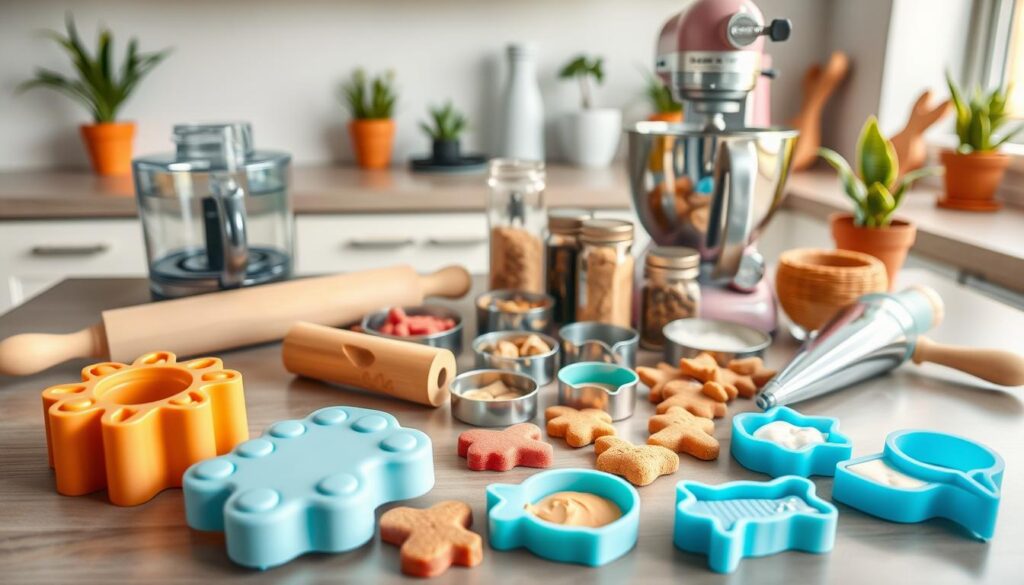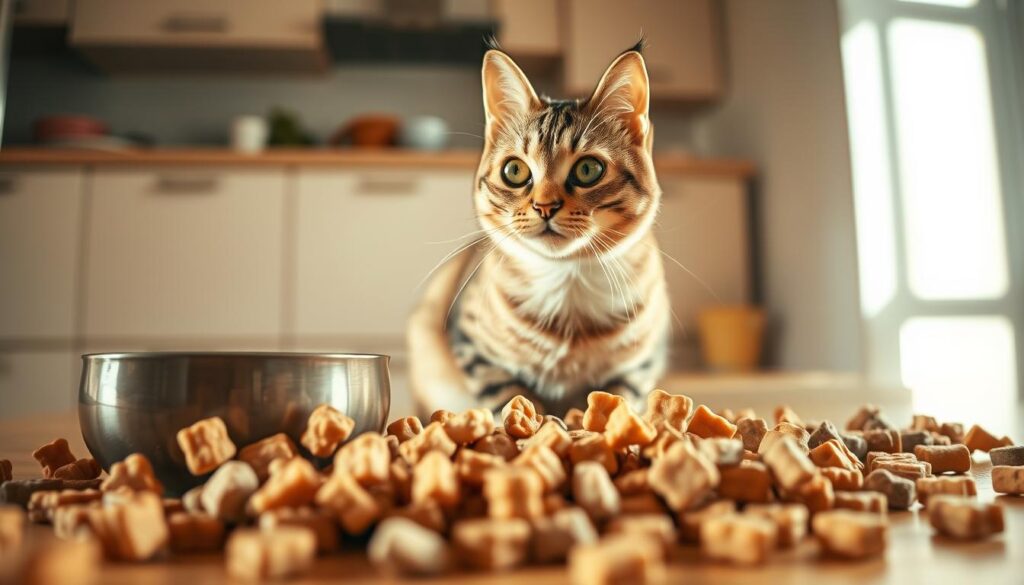As a cat owner, you want the best for your furry friend. Making DIY cat treats at home is a great way to show love. It’s fun and lets you pick safe ingredients for your pet.
Creating simple cat treat recipes at home is a fun way to bond with your pet. We’ll share some easy and delicious homemade cat treats your cat will enjoy.
Key Takeaways
- Benefits of making DIY cat treats at home
- Simple and healthy ingredients for cat treats
- Easy recipes to try with your cat
- Tips for customizing treats for your cat’s preferences
- How homemade treats can improve your cat’s health
Why Make Your Own Cat Treats at Home?
More cat owners are making their own treats. This lets them pick the ingredients. It’s good for cats with special diets or allergies.
Health Benefits of Homemade Cat Treats
Making your own homemade pet treats helps meet your cat’s health needs. You can use natural ingredients to avoid bad stuff in store treats. This can make your cat healthier and lower the chance of some sicknesses.
If your cat’s stomach is sensitive, you can make treats that are easy on it. You can also make treats that fit your cat’s special diet needs.
Cost Savings Over Store-Bought Options
Homemade affordable cat treat recipes save money. Buying ingredients in big lots and planning can cut costs a lot. You also skip the high prices of branded treats.
| Cost Component | Store-Bought Treats | Homemade Treats |
|---|---|---|
| Ingredient Cost | High (due to branding and packaging) | Low (buying in bulk) |
| Preservatives and Additives | Often contain preservatives | No preservatives (using natural ingredients) |
| Customization | Limited flavor and ingredient options | Highly customizable |
By making your own natural cat treats, you save money. You also make sure your cat gets the best ingredients. This is great for cat owners who care a lot about their pet’s health.
Essential Ingredients for Easy Homemade Cat Treats
To make quick and healthy cat snacks, knowing safe and good ingredients is key. The right stuff makes treats tasty and good for your cat.
Protein-Based Ingredients Your Cat Will Love
Cats need a lot of protein to be healthy. Chicken, salmon, and turkey are great for them. These give cats the amino acids they need.
Safe Binding Agents and Flours
Stuff like whole wheat flour and oat flour keep treats together. Eggs and canned pumpkin help them stick too. They’re safe and add nutrition.
Optional Flavor Enhancers
Catnip and dried tuna make treats more fun for cats. Homemade catnip treats need fresh, strong catnip for the best effect.
Try different cat treat ideas to see what your cat likes. Start with small amounts to avoid tummy troubles.
Basic Equipment Needed for DIY Cat Treats
You can make yummy and healthy DIY cat treats at home with a few tools. Making treats for your cat is fun and lets you pick the ingredients. You can also make sure the treats fit your cat’s tastes and health needs.

Kitchen Tools You Already Have
You probably have most of what you need in your kitchen. You’ll need a mixing bowl, measuring cups, and a baking sheet. A mixing bowl helps mix ingredients well. Measuring cups make sure you get the right amounts. A baking sheet is for baking, and parchment paper makes cleanup easy.
Optional Specialized Equipment
Some special tools can make making treats easier and faster. A food processor grinds ingredients finely. A cookie cutter makes fun shapes for your cat’s treats. A famous pet nutritionist said,
“Using the right tools can elevate the quality of your homemade cat treats.”
Think about getting these tools if you make treats often.
Simple Tuna Treats: A Beginner’s Recipe
Tuna cat treats are yummy and simple to make. They’re great for beginners. They’re also a healthy snack for your cat.
Ingredients List
To make these easy homemade cat treats, you need:
- 1 can of tuna in water (drained and flaked)
- 1/4 cup of whole wheat flour
- 1/4 cup of oat flour
- 1 egg
- 1 tablespoon of finely chopped parsley
Step-by-Step Instructions
Here’s how to make your tuna cat treats:
- Preheat your oven to 350°F (175°C). Line a baking sheet with parchment paper.
- In a bowl, mix together the tuna, whole wheat flour, oat flour, egg, and parsley until a dough forms.
- Roll out the dough to about 1/4 inch thickness. Use a cookie cutter or a glass to cut out shapes.
- Place the shapes on the prepared baking sheet and bake for 15-20 minutes, or until firm and lightly browned.
- Allow the treats to cool completely on the baking sheet before transferring them to an airtight container.
Storage Tips
To keep your homemade tuna cat treats fresh, store them in an airtight container in the fridge. They last up to a week. You can also freeze them for up to 3 months. Just thaw at room temperature when you’re ready to serve.
Chicken Delight Treats for Picky Eaters
Cats with finicky appetites will love these easy-to-make chicken delight treats. Making your own homemade pet treats lets you pick the ingredients. This way, you can make sure they fit your cat’s tastes and needs.
Ingredients List
To make these tasty treats, you’ll need:
- 1 cup of cooked, shredded chicken
- 1/2 cup of whole wheat flour
- 1/4 cup of finely chopped parsley
- 1 egg
Step-by-Step Instructions
Here’s how to make your chicken cat treats:
- Preheat your oven to 350°F (175°C).
- Mix the shredded chicken, whole wheat flour, and chopped parsley in a bowl.
- Add the egg to the mix and stir until it forms a dough.
- Roll out the dough to about 1/4 inch thick. Use a cookie cutter for fun shapes.
- Bake for 15-20 minutes until they’re firm and lightly browned.
Variations to Try
Try these fun changes to keep your cat interested:
- Add a teaspoon of dried catnip for a special flavor.
- Use different cookie cutters for various shapes and sizes.
- Try oat flour instead of whole wheat flour for a different feel.
By making your own homemade pet treats, you can give your cat healthy snacks. These chicken delight treats are perfect for even the pickiest eaters.
Catnip-Infused Crunchy Treats
Making catnip treats at home is easy and fun. These treats mix catnip with a crunchy texture cats enjoy. You can make sure they’re healthy and free from bad stuff.
Ingredients List
Here’s what you need for these treats:
- 2 cups of whole wheat flour
- 1/2 cup of oat flour
- 1/4 cup of finely chopped catnip
- 1/4 cup of grated cheddar cheese
- 1 egg
- 1 tablespoon of olive oil
Step-by-Step Instructions
Here’s how to make these treats:
- Preheat your oven to 350°F (175°C).
- Mix whole wheat flour, oat flour, and catnip in a big bowl.
- Beat an egg and mix it with cheese and olive oil in another bowl.
- Put the wet and dry ingredients together to make dough.
- Roll the dough to 1/4 inch thick and cut out shapes with a cookie cutter.
- Bake for 15-20 minutes until they’re crunchy.
- Let the treats cool before giving them to your cat.
The Perfect Catnip Amount
Using the right amount of catnip is key. Too little, and your cat might not care. Too much, and it could be too strong. Use about 1/4 cup of catnip for every 2 cups of flour. This gives a nice flavor without being too strong.
| Ingredient | Quantity | Purpose |
|---|---|---|
| Whole Wheat Flour | 2 cups | Base ingredient for the treats |
| Oat Flour | 1/2 cup | Adds texture and fiber |
| Catnip | 1/4 cup | Provides the catnip flavor |
| Cheddar Cheese | 1/4 cup | Adds flavor and nutrition |
Grain-Free Salmon Bites for Sensitive Cats
Homemade grain-free salmon bites are great for cats with allergies. They taste good and meet their dietary needs. They avoid common irritants in regular cat treats.
Ingredients List
To make these grain-free salmon bites, you’ll need:
- 1 can of salmon
- 1/2 cup of coconut flour
- 1/4 cup of finely chopped parsley
- 1 egg
Step-by-Step Instructions
Follow these simple steps to create your grain-free salmon bites:
- Preheat your oven to 350°F (175°C).
- Mix the salmon, coconut flour, parsley, and egg in a bowl until well combined.
- Shape the mixture into small bite-sized balls.
- Place the balls on a baking sheet lined with parchment paper.
- Bake for 12-15 minutes or until firm.
- Allow the treats to cool completely before serving.
“Making your own cat treats can be a fun and rewarding experience,” says a feline nutritionist. “It’s a great way to ensure your cat is getting the nutrients they need without the additives found in commercial treats.”
Benefits for Cats with Allergies
Grain-free salmon bites are great for cats with allergies. They don’t have wheat or corn. Salmon is a good protein, and coconut flour is a gentle binder.
These treats are hypoallergenic and full of omega-3 fatty acids. They help keep your cat healthy.
Adding these grain-free salmon bites to your cat’s diet is a good choice. They are nutritious and safe. But, always talk to your vet before changing your cat’s diet.
Quick and Easy Homemade Cat Treats for Busy Pet Parents
Making homemade cat treats is easy, even for busy pet owners. You can give your cat healthy, tasty treats without spending hours cooking.
No-Bake Treat Options
No-bake treats are perfect for busy pet parents. They don’t need oven time, saving you time and energy. Here are some easy no-bake recipes:
- Peanut butter and banana bites
- Pumpkin and yogurt drops
- Sardine and cream cheese rolls
These treats are quick to make and full of nutrients your cat will enjoy.
Make-Ahead and Freeze Methods
Make treats ahead and freeze them to save time. Many recipes can be frozen for later. Just thaw what you need when it’s time to give them to your cat.
To freeze treats well:
- Make your treats as the recipe says.
- Put them on a baking sheet lined with parchment paper.
- Freeze until solid, then put them in an airtight container or freezer bag.
Time-Saving Tips
Here are tips to make homemade cat treats quicker:
- Use ingredients you already have at home.
- Get ingredients ready before you start, like measuring dry ingredients.
- Keep your kitchen organized to save time.
With these tips, you can make homemade cat treats with your cat, even on busy days.
Troubleshooting Common Issues When Making Cat Treats
Making homemade cat treats is a fun way to keep your cat healthy. But, you might face some problems. Here are some tips to help you fix common issues.
Fixing Treats That Are Too Dry or Crumbly
If your treats are too dry or crumbly, it might be because of overbaking. Or maybe you used too much flour. To fix this, add more moisture like an extra egg or tuna juice. Try baking for less time or at a lower temperature. Check your oven temperature to avoid dryness.
What to Do If Your Cat Rejects the Treats
If your cat doesn’t like the treats, it might be the ingredients or texture. Cats can be very picky. Try changing the recipe or adding flavors like catnip or greenies. Make sure the treats are fresh and stored well.
Extending Shelf Life of Homemade Treats
To keep your treats fresh longer, store them in an airtight container in the fridge. Freezing is also a good option. Use airtight containers or freezer bags to prevent freezer burn. Always check the treats for freshness before giving them to your cat.

By using these tips, you can make better DIY cat treats. Your cat will love them! Happy baking!
Conclusion
Making homemade cat treats is fun and easy. It’s a great way to show your cat you care. You can make treats that your cat will love and that are good for them.
When you make treats at home, you avoid bad stuff found in store treats. This makes your cat’s snacks healthier. The recipes in this article are a good place to start. Soon, you’ll be making yummy treats for your cat.
Why not try making treats for your cat? Use these easy recipes and see how much your cat enjoys them. Homemade treats help you bond with your pet and give them a better snack time.
FAQ
What are the benefits of making homemade cat treats?
Making homemade cat treats lets you pick the ingredients. This means your cat gets the best food. You can also avoid bad stuff found in store treats.
Are homemade cat treats cost-effective?
Yes, they can save money. Buying big and making lots of treats at once is cheaper than store ones.
Can I use human food to make cat treats?
Some human foods are okay for cats. But, make sure they’re safe and good for your cat. Always check before making treats.
How do I store homemade cat treats to keep them fresh?
Keep them in airtight containers. Glass jars or plastic with tight lids work well. Freezing them also helps. Always check if they’re still good before giving them to your cat.
Can I customize homemade cat treats for my cat’s dietary restrictions?
Yes, you can make treats just for your cat. This is great if your cat has allergies or special needs. You can pick safe and healthy ingredients.
Are there any simple DIY cat treat recipes for beginners?
Yes, there are easy recipes for beginners. Try tuna treats, chicken delight, or catnip treats. These are great for starting out and can be made to fit your cat’s tastes.
How can I make homemade cat treats more appealing to my cat?
Use your cat’s favorite foods like chicken or salmon. Adding catnip or other flavors can also make them more fun.




